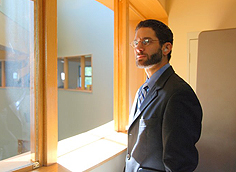
Darby Jared Leigh, the first deaf Reconstructionist rabbi, visited Gallaudet on November 12 for a special Shabbat presentation entitled “From Locks to Lox.” In his talk, Rabbi Leigh described a journey of self-discovery that he undertook through study, experience–and hair.
“I consider myself a truth seeker,” Leigh said. “That search took me to a lot of different places.” In 1993, his quest led him to spend a year studying at Gallaudet–a time he called “hugely impactful” on his path to defining his deaf identity. Leigh intended to stay for one semester, but extended his time to a full year.
Photo: Rabbi Darby Jared Leigh, the first deaf Reconstructionist rabbi, presented at Gallaudet on November 12. Photo: Lauren Shay Lavin Photography
During his presentation, Leigh explained to the audience of about 40 students, faculty, staff, and community members how he first made his curly mane into dreadlocks and what it came to mean to him.
Leigh was always curious about religious and spiritual traditions, he told the gathering. This interest led him to study and follow the practices of a number of world religions. At the same time, he always had a fascination with his hair. “I tried just about every hair style,” Leigh said. “I dyed my hair different colors–red, green, black, orange. I even bleached it blond. I grew my hair out into a ‘Jew-fro,’ I shaved it off, I even wore a Mohawk. I just loved expressing myself through my hair.”
When Leigh was a student at the University of Rochester (N.Y.), a friend said his hair would be perfect for dreadlocks. Leigh tried it, and maintained the dreadlocks, never cutting his hair for many years. He soon landed a part on tour with the National Theatre of the Deaf, where he was encouraged to keep that distinctive look.
As his locks grew, Leigh discovered more about the meaning behind the hair style. His research on the Rastafarian tradition pointed him toward the Torah, where he read a passage about the Nazarites. The text, which is especially significant in the Rastafarian tradition, explained the important role that uncut hair played for a Nazarite–a man or woman who “dedicated” him/herself, by taking certain vows, to being in an intimate relationship with the Divine. The Nazarites might typically be seen as solitary spiritual seekers, and Leigh felt an instant affinity with the idea that such a seeker might have a place in the Jewish textual tradition
Leigh continued to grow his hair, but with a new appreciation for what the dreadlocks could mean. He kept the locks even after the theatre tour ended and through his time studying religion at Columbia University. It was not until he had entered the Reconstructionist Rabbinical College in Pennsylvania that Leigh felt it was time to cut his hair. Following his ordination as a rabbi in 2008, Leigh took his current position as assistant rabbi at Bnai Keshet synagogue in Montclair, N.J.
The presentation came to a close with questions from the audience. Then Leigh led the traditional blessings over the meal and the group enjoyed a kosher Shabbat dinner.
The event was sponsored by Hillel, the organization for Jewish life on campus. It is part of a series of events that has included Rosh Hashannah dinner to ring in the Jewish new year earlier this fall and a Shabbat presentation with Rebecca Dubowe, the first deaf woman to be ordained a rabbi, in the spring.
“I was thrilled to have Rabbi Leigh celebrate Shabbat with us at Gallaudet,” said Hillel Director Paula Tucker. “He is warm, engaging, and someone with whom the Gallaudet Jewish community can relate. He managed to weave Jewish textual study in with his own story, making the presentation all the more enjoyable.” With speakers like Dubowe and Leigh, Tucker said, “The goal is always to enhance Jewish knowledge, and to deepen the sense of pride the Gallaudet Jewish community feels in its Jewish heritage.”
Leigh is often sought after as a speaker, but his visit to Kendall Green held special meaning. Much like his decision to study Judaism was a kind of homecoming, he said, coming to Gallaudet was “another way of coming home.”
–Rhea Yablon Kennedy
Source: aaweb.gallaudet.edu/x45930.xml




